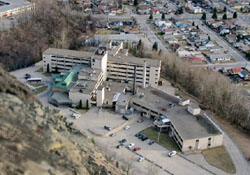INTERVIEW: Frank Marino of Interior Health responds to surgeons
Last week the Telegraph interviewed Dr. Andre De Greef, head of surgery at KBRH, to address doctor’s concerns about looming cuts to the OR. This week we’ve got a reply to that story from Frank Marino, the Health Service Administrator for Trail and Castlegar.
When did you hear from surgeons about the issue and paying for their own nurses? They’ve said they have been trying to talk about the issue for a number of months.
In terms of changes that we were contemplating for the OR, those started over a year ago in terms of looking at that budget and doing what we can to stay within our resources. The question about paying for nurses just came out three weeks ago, and that was the first time anyone heard about that. That came out after we told the docs and staff that we were changing the schedule and reducing the number of OR slates.
What was the reasoning behind the proposed OR cuts? How did you arrive at cuts to the OR as the solution? The surgeons have suggested a best practice of first funding essential care, then seeing what’s left for everything else.
What happened is that when Interior Health is looking at staying within our budgets, the first issue was looking at any unfunded positions in the system. There were unfunded jobs out there. In other words, there were people working with no real budget behind them. We identified positions in our OR department that were in that situation. Part of the plan was to eliminate those positions. This has happened over the years as jobs have come up that weren’t properly funded. Then we end up in a situation that, when the budgets get tight, we have to do something about it.
The surgeons have said there is plenty of money in the system but that it’s being misspent and too much money is going into administration and not enough into patient service. What’s the thinking at IH about when, where, and how to make cuts?
The first principle that interior Health has always used is to try and protect patient care. This year we’ve looked at administrative efficiencies and looked at management jobs. We’re looked at travel, education, and those types of things that have less of an effect on direct patient care. In our area here, with the East Kootenay and Kootenay Boundary, we combined our senior leadership teams so that we could cut some positions. We used to have a COO in the Kootenay Boundary and one in the East Kootenay. So we had two and now we have one as an example of cutting administrative positions so we affect patient care as little as possible.
People always comment about how many administration positions we have but over the years since 2002 I’ve seen many management positions being cut. It’s difficult for anyone to convince me that we are too heavy on the administration side.
What are your thoughts on the current levels of service being offered at KBRH?
Well, I mean Kootenay Boundary Regional Hospital is the regional hospital in the area we do comparisons with other sites, which is part of our plan with the OR as well. We compared how much time, for example, surgeons of a different specialty had in terms of OR slates. Even with the propped cuts coming in next April, we would still have as good or better access than most comparable places in Interior Health.
That seems to be an issue of contention. The surgeons have said that is not in fact the case and that only certain favourable numbers were compared while other important numbers were left out and that in terms of orthopaedics and shoulder procedures, Trail is actually significantly worse than other hospitals in the province. What are your thoughts on that statement?
The numbers for the waiting list times that our focus has been on is hip and knee replacements and cataracts, so we’ve looked and based this on those numbers. Wait times are sort of a difficult issue because not everyone does them exactly the same in terms of how they look at the wait times. The wait times on those three procedures compare favourably with other hospitals around the province. In terms of the other procedures’ wait times, I can’t comment in terms of what the comparisons are. I know that different surgeons have different lengths of waiting lists depending on what they are doing. That is one of the realities in health care in Canada is that we do have waitlists. We try to prioritize those waitlists with the surgeons to see who should be in first and that sort of thing. If something becomes urgent we fit them in earlier.
In terms of the wait times, the comparisons do look favourable at this time.
What are Interior Health’s thoughts on surgeons possibly paying for their own nurses to maintain the service levels?
It’s an idea that came up with the surgical group, and I think part of it was them trying to tell us how concerned they are about it that they would be willing to look at that. What we said to them was, ‘let’s look at that and see what it would actually mean’. No one has actually come up with a solid plan, so we want to sit down with them and talk about that. We also want to sit down and talk about whether or not there are other options to make this work. So that is just one of the options we will discuss. On our side, we are getting people looking at statistics, and then we’ll meet with the surgical group to see what we can do to work this out.
What is the next move forward on IHA’s part?
Well I did meet with some surgeons on Monday morning and told them that our CEO, Dr. Halpenny, has said that we will have a meeting, discuss the issues and see what we can do to work with our surgical group. We all want to maintain KBRH as our regional hospital in the area.
In an ideal world, what do you see as the solution to the current issue?
In an ideal world we wouldn’t even be talking about this because we wouldn’t have had to look at changes to make our budgets work. The reality is that we have to sit down together and say, ‘here are our resources–how do we make it work and what is the plan for this year and the years after?’. That’s really what it all comes down to. You can never satisfy anyone in terms of OR and nursing time that we have. It’s always a balance of what resources do we have and what services can we provide. If it was just a simple answer than it would have been solved years ago.
Last week the surgeons commented that if they keep getting ignored they may have to change or break the system. Do you have any thoughts or a reply to that?
The next step is sitting down with the group, looking at some numbers and seeing what we can do to avoid that. No one wants that to happen, the surgeons don’t want it, IHA doesn’t want it and the minister of health doesn’t want it. We all have to just get together and figure out the solution to do the best we can with what we have. I’ll be meeting with the surgeons group in the next two weeks to discuss this and see what we can do about it.























